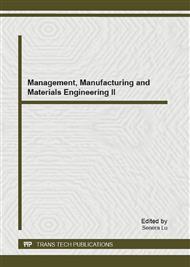[1]
Buzacott. J. A. The Impact of Worker Differences on Production System Output. International Journal of Production Economics, 2002, 78(1): 37-44.
DOI: 10.1016/s0925-5273(00)00086-4
Google Scholar
[2]
Gokcen H., Agpak K. A Goal Programming Approach to Simple U-line Balancing Problem. European Journal of Operational Research, 2006, 171: 577-585.
DOI: 10.1016/j.ejor.2004.09.021
Google Scholar
[3]
Slomp, J., Bokhorst, J., Molleman, E. Cross-training in a Cellular Manufacturing Environment. Computers and Industrial Engineering, 2005, 48(10): 609-624.
DOI: 10.1016/j.cie.2003.03.004
Google Scholar
[4]
Azizi, N. Zolfaghari S., Liang M. Modeling Job Rotation in Manufacturing Systems: the Study of Employee's Boredom and Skill Variations. International Journal of Production Economics, 2010, 12: 69-85.
DOI: 10.1016/j.ijpe.2009.07.010
Google Scholar
[5]
Niemi, E. Worker Allocation in Make-to-order Assembly Cells. Robotics and Computer-Integrated Manufacturing, 2009, 25(6): 932-936.
DOI: 10.1016/j.rcim.2009.04.008
Google Scholar
[6]
Corominas A., Pastor R., Plans J. Balancing Assembly Line with Skilled and Unskilled Workers. Omega, 2008, 36( 6) : 1126-1132.
DOI: 10.1016/j.omega.2006.03.003
Google Scholar
[7]
Digiesi S., Kock, A., Mummolo, G., Rooda J. The Effect of Dynamic Worker Behavior on Flow Line Performance. International Journal of Production Economics, 2009, 120( 2) : 368-377.
DOI: 10.1016/j.ijpe.2008.12.012
Google Scholar
[8]
Dimitriadis S. Assembly Line Balancing and Group Working: A Heuristic Procedure for Workers' Groups Operating on the Same Product and Workstation. Computers and Operations Research, 2006, 33: 2757-2774.
DOI: 10.1016/j.cor.2005.02.027
Google Scholar
[9]
Cevikcan. E., Durmusoglu M., Unal M. A Team Oriented Design Methodology for Mixed Model Assembly Systems. Computer s and Industrial Engineering, 2009, 56( 2) : 576-599.
DOI: 10.1016/j.cie.2007.11.002
Google Scholar
[10]
H. YUE, J. SLOMP, E. MOLLEMAN and D. J. VAN DER ZEE: Worker flexibility in a parallel dual resource constrained job shop. J. International Journal of Production Research, 2008, 46(2), 451–467.
DOI: 10.1080/00207540601138510
Google Scholar


